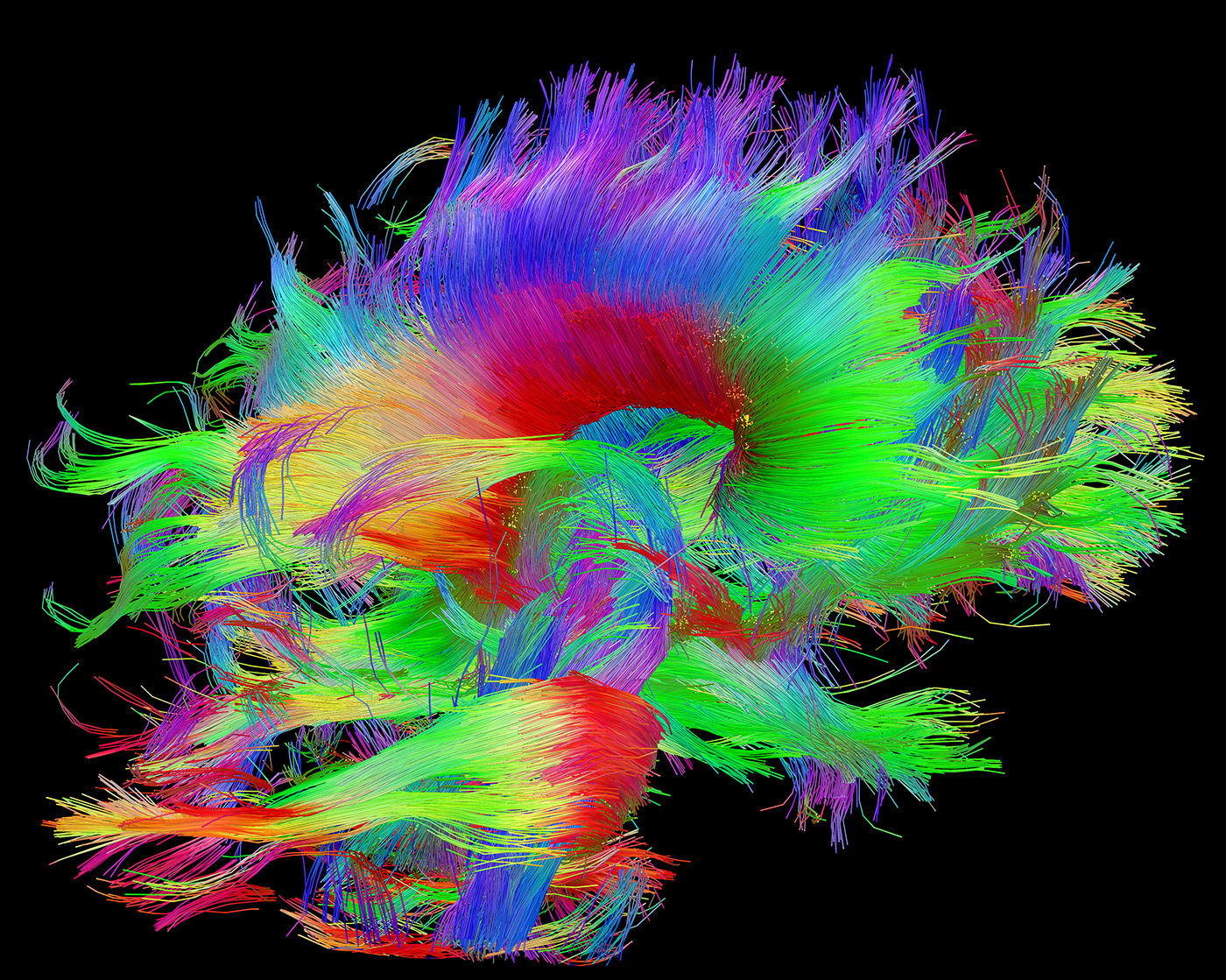For the Re:research series, we invite artists and writers to present the underpinnings of their work. In this post, Erik Frydenborg expounds on his research behind an exhibition he curated, also titled Immortal Jelly, at AWHRHWAR from September 6–October 6, 2018. Part II of this essay is forthcoming on X-TRA Online.

White Matter Fibers, HCP Dataset Full sideview. Courtesy of the USC Laboratory of Neuro Imaging and Athinoula A. Martinos Center for Biomedical Images, Consortium of the Human Connectome Project (www.humanconnectomeproject.org).
Am I losing my mind?
Most theories of Mind begin with the coincidence of consciousness and autonomous reason in a biological vessel. Whole brain emulation (WBE) seeks to liberate the mind from the corporeal self. Its goal is to replicate the discrete quantum functions of organic brain tissue in a synthetic substrate—essentially, to turn the brain into software. We’re accustomed to effortless digitization, and it’s easy to fantasize about the wholesale conversion of the brain into code. Popular entertainment and transhumanists alike predict the fast-approaching implementation of this sort of cloud-hopping WBE. But researchers describe actual progress as an excruciating crawl. The structural difficulty of scanning and reproducing a living human brain’s 100 billion neurons—and each of their 8,000 synaptic connections to other neurons, along with a host of infinitesimal operations within each synapse—is simply breathtaking. The efficiency implied by the breezy phrase “mind uploading” belies the enormous complexity of the task.
The engineering dilemma looms large, casting a shadow over the ethical and philosophical questions that inevitably follow: What is bodiless personhood? What cost attends the hubris of bypassing death? Our instincts warn against this sort of tampering with the natural order. But broader comprehension of the metaphysical proposals of WBE lags behind the technology itself by decades, corresponding more closely with the pulp fiction of the twentieth century. John Sladek’s rambling science fiction satire The Müller-Fokker Effect (1970) centers around the accidental creation of the world’s first computerized man: a low-level corporate employee named Bob, whose body is destroyed in a military-industrial experiment gone wrong; his salvaged “personality” is stored on pink reel-to-reel tapes.

John Sladek, The Müller-Fokker Effect, 1970. Carroll & Graf edition (1990) pictured. Photo: Travis Diehl.
After the accident, Sladek’s protagonist continues to exist in a kind of stateless reality—a semi-lucid amnesia, expressed through steady stream-of-consciousness gibberish. The character’s cybernetic aphasia is rendered by the author as a hyperactive, all-caps word salad: “THE RUINS, AUTOPSY OF FIRED, BESTRIDED REAL LIVES, TOO. WHAT PRUNE OF ‘IF,’ OR ITS LESSER GOODNESS? HE UNSTOPS BEST ALLIES, TOO, RETHATCHED KING THISTLE BOTHERS EVIL ENDS. REQUESTED RICE.” Bob’s condition is unclear. Has he entered a state of suspended animation? A coma? An afterlife? Another dimension? These stumbling attempts to translate the mental coordinates of his encoded self are punctuated by a recurring phrase, repeated like a mantra on a loop: jelly days jelly days jelly days. At the novel’s end, Bob is reconstituted from the tapes in a freshly commandeered body. He recollects his time as a conscious recording, insisting that he hadn’t died but had lived a “different” life, made up of “this and that, old memories, odd thoughts.” He describes the reverie of Jelly Days as a mundane parallel universe, where “everyone has to work at their former job” and “you can only communicate with the living through accidents or imitation.” He decides that Jelly Day means “the day one leaves one’s mortal jelly.”

Sony TC-800B Tape Recorder used in the Nixon Oval Office. Records of the Watergate Special Prosecution Force, RG 460. Public domain.
If this analog mysticism seems hopelessly primitive and contrived, consider our continued use of the atavistic term “tape” to describe digital recordings, even though they quantize signals as numerical values, not magnetic fluctuations or physical textures (and usually involve no tape at all). The ingrained verbiage of tape recording stubbornly persists; our inability to adopt new, more relevant vocabulary stems from the haptic familiarity of tape as a tangible site for information, versus the amorphous rootlessness of binary data storage. Zeros and ones are everywhere and nowhere. Tape is a place.
While we might perceive a quickening dematerialization of technology, many of today’s advanced systems continue to rely on mammalian morphology and lifelike response in order to function. Biometric authentication uses fleshly traits like fingerprints, hand geometry, facial structure and thermography, iris and retinal distinction, and DNA profiles to establish identity. Computers managing everything from bank accounts to combat drones incorporate these data sets, measuring them against the living tissue of actual people.

Sgt. Ryan McCamy uses Handheld Interagency Identity Detection Equipment (HIIDE) during a cordon-and-search operation at an apartment complex in eastern Baghdad. Public domain.
Recently developed video software has enabled sophisticated new methods of hijacking identity. In an inversion of automated facial recognition, programmers are now able to manipulate footage of talking heads and change the content of their speech. This facial synthesizing fast became infamous, as doctored clips of world leaders transformed into helpless ventriloquists’ dummies were disseminated across the internet. Viral videos like these in our media regimen contribute to a creeping sense of fraudulence. Arguably, though, our reflexive aversion to this phenomenon is due as much to the fact that it drags us into the uncanny valley, as we react with disgust to these telegenic but not-quite-convincing simulations. Our natural awareness of the unnatural distresses our limbic brains.
Comparable responses meet the widely-memed footage of quadrupedal robots from Boston Dynamics, often mordantly cited as harbingers of an imminent rise of the machines. The unease generated by these automata comes not only because they’ve been militarized, or because of any threatening directive, but because of how closely they approximate the anatomies and movements of lower mammals—particularly dogs. Confronted with videos of these combustion-powered canines, the autonomic nervous system stirs, recovering preconscious memories of humanity’s early predators. Where the vanguard machine is derived from an ancient biological design, the human response to that machine is likewise informed by the archaic mind.
We’re all too aware of the inevitable degradation of our bodies and minds, and we tend to think of science as a way to mitigate our inbuilt physical limits. But if technological progress is bound to the evolution of the primeval organism, how can we liberate the brain from its natural infrastructure?
A possible model for deliverance is found in Turritopsis dohrnii, the immortal jellyfish. This invertebrate escapes natural death through a process of reversion. At the onset of adversity factors like environmental stress, starvation, age, or illness, the endangered jelly devolves instead of dying, again becoming a polyp—which will itself bud anew, releasing medusae genetically identical to those of its prior life cycle. This rare and inscrutable ability, known as transdifferentiation, involves the conversion of one type of functional cell into another. The immortal jelly is one of the only known animals capable of such thorough cellular reprogramming.

Turritopsis nutricola, hydroid and young medusa. From William K. Brooks, Memorial pamphlet containing certain drawings of Medusae, 1909. Public domain.
As waters warm, the impassive Turritopsis thrives—replicating and hitchhiking in ship ballast discharge, proliferating across every ocean in the world. These hydrozoan swarms float through liquid time and liquid space, limited only by the uncertain future of the oceans themselves. It is conceivable that this, one of the earliest types of living creatures, might also be one of the last.
But even as they elude death, these resilient beings—alas—have no brains. Like all jellyfish, Turritopsis has radially distributed nerves that detect touch, temperature, light, and salinity; automatic responses to these and other stimuli replace conscious behavior. Like its other anatomical functions (a single orifice serves as both mouth and anus, while oxygen is diffused directly through the epidermis rather than via aspiration and circulation), the jelly’s radically simple nervous system allows for a sentient existence free from cognition—a life of reflex without thought.
If we put aside theological concepts of eternity in favor of the literal, it is possible to imagine a far-future world populated solely by these two extreme but diametrically opposed models of practical immortality: the insensate mind and the mindless sensor. By land, endless server networks, filled with the integrated circuitry of billions of bodiless, encoded brains. And by sea, vast drifting hordes of unthinking, gelatinous biomass, cyclically regenerating.
As we try to grasp these exotic modes of extended survival, we can only perceive them dimly across the expanse; our vision is occluded by our as yet inescapable finitude. Our own brief sentience is marked by a drive to retain some trace of ourselves, beyond the constraints of linear time. We imprint personal gestures in whatever substrates are available—replicating genetic code, molding inert matter—hoping those gestures might one day be recalled. The latter method may seem more like a shadow of existence, but accidents of history have shown that even tape recordings can be highly durable. Sometimes, such documents embody the predicament of human transience, between mind and mindlessness, with crystalline clarity. x

Erik Frydenborg is an artist who lives in Los Angeles. Frydenborg is one of four artist-operators of the Highland Park gallery AWHRHWAR.